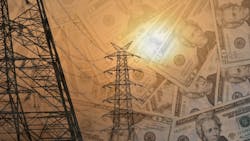Power and Utility Megaprojects Run 35% Over Budget on Average
A new report from EY, Spotlight on power and utility megaprojects — formulas for success, reveals power and utility megaprojects run 35% (US$2b) over budget and behind schedule by two years on average.
EY analyzed 100 of the world's largest (by capital expenditure) power generation, transmission and distribution and water projects across all asset life cycle stages — from pre-financing through to decommissioning — and found that 64% of these projects experienced delays and 57% were over budget.
Safia Limousin, EY Global Power & Utilities, Capital & Infrastructure Leader, says: "Large and complex power and utility megaprojects are under massive pressure to come in on time and budget. And yet the majority of all megaprojects in the sector don't. This worldwide phenomenon often comes with a large price tag for overrunning costs that companies can't afford any longer."
The highest reported average delays occurred in North America (a little under three years), while South America reported the highest average cost overruns at nearly 60%.
Almost three quarters (74%) of hydropower, water, coal and nuclear infrastructure projects were over budget by 49% on average, with hydropower and nuclear projects typically suffering the greatest cost overruns at US$4.6b and US$4b, respectively. Project delays were longest for coal and hydropower technologies, at nearly three years on average. Meanwhile, offshore wind and gas-powered generation projects saw significantly less delays and cost overruns.
Eighty percent of executives surveyed identified financing and delivering projects on schedule and on budget as a top challenge. And the majority also believe project financing (64%) and delivering (70%) challenges will continue in the future. Investment in power sector infrastructure is expected to be close to US$20t from 2016 to 2040.
Limousin says: "Cost overruns and late delivery are symptoms of greater underlying problems in the power and utilities sector. Companies must address these issues head-on in the next wave of infrastructure investment or risk sacrificing the full economic and social benefits megaprojects offer. That means leveraging leading practices and innovations to enhance value."
The report outlines how harnessing digital innovation is an important step toward more effective control and enhanced project performance. Embracing innovations in project fitness assessment, big data management and decision support management methods, for instance, can improve power and utilities companies' ability to formulate a holistic view of projects and accurately anticipate and address time and cost overruns to keep them on track.
EY conducted a survey of executives from power and utility (P&U) organizations with a turnover ranging between US$900m and more than US$5b, using a structured survey questionnaire. Of the 204 respondents, 25% of the respondents was a C-suite executive, with the remainder at director level across five functional areas comprising finance, strategy, operations, procurement and projects/programs. The respondent geographical split was as follows: 23% from Asia-Pacific, 43% from EMEIA and 34% from Americas. The study targeted executives working in different P&U segments: power generation (nuclear, hydro, coal, gas and renewables), transmission and distribution, and water.
EY analyzed the performance of 100 of the world's largest megaprojects (by capital expenditure) all featuring time and cost overrun figures reported publicly (in press releases, news articles, company websites, annual reports and/or other articles). These include power generation, transmission and distribution, and water projects, across all stages of the project life cycle, from pre-financing through decommissioning, and were identified from Infrastructure Journal's project database in April 2016.
Time delays and cost overruns were calculated based on the latest available reported figures. In instances where a project was delayed but no expected completion date was available, the delay was calculated as of 30 April 2016. Where project cost data was denominated in currency other than US dollars, the currency conversion to US dollars was applied using exchange rates prevalent on 5 May 2016.
Identification of the 100 megaprojects and the associated performance metrics have been prepared on a "best efforts" basis, based on publicly available information. The performance of individual companies and projects is not discussed, disclosed or implied. Any broader industry commentary is based on general industry observations and not on the views of any single organization.
